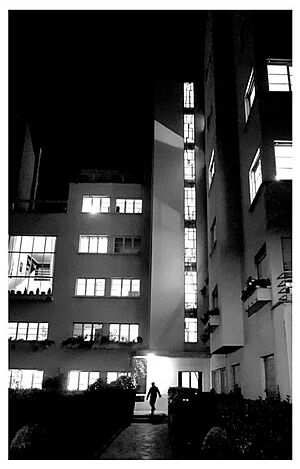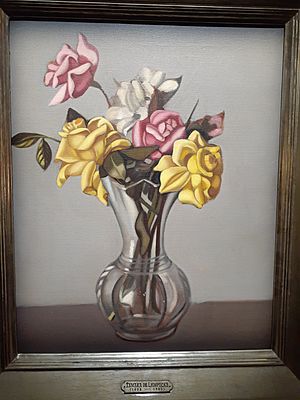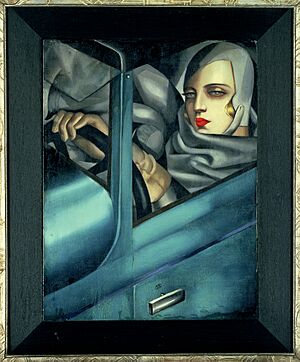Tamara de Lempicka facts for kids
Quick facts for kids
Tamara de Lempicka
|
|
|---|---|
| Tamara Łempicka | |

|
|
| Born |
Tamara Rosalia Gurwik-Górska
16 May 1898 |
| Died | 18 March 1980 (aged 81) |
| Nationality | Polish |
| Education | Académie de la Grande Chaumière in Paris |
|
Notable work
|
La Belle Rafaela (1927) Self-portrait, Tamara in a Green Bugatti (1929) Les Jeune Fille Aux Gant (1930) Woman with Dove (1931) Adam and Eve (1932) |
| Style | Art Deco |
| Spouse(s) |
Tadeusz Łempicki
(m. 1916; div. 1931)Raoul Kuffner de Diószegh
(m. 1934; died 1961) |
| Children | Maria Krystyna 'Kizette' Łempicka Foxhall (daughter) (1916–2001) |
| Relatives | Adrienne Górska, architect (sister) |
Tamara de Lempicka (born Tamara Rosalia Gurwik-Górska; 16 May 1898 – 18 March 1980) was a famous Polish painter. She spent most of her career in France and the United States. She is well-known for her smooth, stylish Art Deco portraits of important people.
Tamara was born in Warsaw, Poland. She later moved to Saint Petersburg, Russia, where she married Tadeusz Łempicki, a Polish lawyer. They then moved to Paris, France. She studied painting with Maurice Denis and André Lhote. Her unique style mixed elements of cubism and neoclassicism. She was very active in the art scene of Paris between the two World Wars. In 1934, she married Baron Raoul Kuffner, a wealthy art collector. People sometimes called her "The Baroness with a Brush."
When World War II started in 1939, Tamara and her husband moved to the United States. There, she painted portraits of celebrities and still lifes. In the 1960s, she also created some abstract paintings. Her art style became less popular after World War II. However, it became popular again in the late 1960s when the Art Deco style was rediscovered. She moved to Mexico in 1974 and passed away in 1980. Her ashes were scattered over the Popocatépetl volcano, as she wished.
Contents
Early Life and Art Beginnings
Growing Up in Warsaw and St. Petersburg (1898–1917)
Tamara was born on May 16, 1898, in Warsaw, which was then part of the Russian Empire. Her father, Boris Gurwik-Górski, was a lawyer for a French company. Her mother, Malwina Dekler, was a Polish socialite.
Tamara was raised in Warsaw by her mother and grandparents. Her grandparents, Bernard and Klementyna Dekler, were well-known in society. They were friends with famous musicians like Ignacy Jan Paderewski and Artur Rubinstein.
When Tamara was ten, her mother hired an artist to paint her portrait. Tamara did not like posing and was unhappy with the finished painting. So, she took the art supplies, asked her younger sister to pose, and painted her first portrait herself.
In 1911, her parents sent her to a boarding school in Lausanne, Switzerland. She found it boring and pretended to be sick so she could leave. Instead, her grandmother took her on a trip to Italy. This trip helped her discover her love for art. After her parents divorced in 1912, she spent a summer with her rich Aunt Stefa in Saint Petersburg, Russia.
In 1915, in St. Petersburg, she met and fell in love with Tadeusz Łempicki, a well-known Polish lawyer. Her family offered him a large gift of money for their marriage. They got married in 1916 in St. Petersburg.
Escaping the Russian Revolution
Their comfortable life changed with the Russian Revolution of 1917 in November 1917. In December 1917, Tadeusz Łempicki was arrested by the secret police. Tamara searched many prisons to find him. With the help of the Swedish consul, she managed to get him released. They traveled to Copenhagen, then to London, and finally to Paris, where Tamara's family had also found safety.
Art Career in Paris
Starting as an Artist (1918–1939)
In Paris, the Łempickis lived for a while by selling family jewels. Tadeusz struggled to find suitable work. Their daughter, Maria Krystyna, nicknamed "Kizette," was born around 1919. This added to their financial needs. Tamara decided to become a painter, following her sister's idea.
She studied at the Saint Petersburg Academy of Arts and the Académie de la Grande Chaumière with Maurice Denis. Later, she studied with André Lhote, who greatly influenced her style. Her first paintings were still lifes and portraits of her daughter Kizette and her neighbor. She sold her first paintings through a gallery called Galerie Colette-Weil. This allowed her to show her work at important art exhibitions in Paris. She first exhibited at the Salon d'automne in 1922. During this time, she signed her paintings "Lempitzki," which was the male form of her name.
Her big break came in 1925 at the International Exhibition of Modern Decorative and Industrial Arts. This exhibition later gave its name to the Art Deco style. She showed her paintings at two major venues there. American journalists from magazines like Harper's Bazaar noticed her work, and her name became known.
In the same year, she had her first big exhibition in Milan, Italy. For this show, Lempicka painted 28 new works in just six months. During her trip to Italy, she was invited to meet the famous Italian writer Gabriele d'Annunzio. She visited him twice at his home, hoping to paint his portrait. She was unsuccessful and left feeling frustrated.
In 1927, Lempicka won her first major award. She received first prize at an exhibition in Bordeaux, France, for her portrait of Kizette on the Balcony. In 1929, another portrait of Kizette won a bronze medal at an international exhibition in Poznań, Poland.
In 1928, she divorced Tadeusz Łempicki. That same year, she met Raoul Kuffner, a baron and art collector. His family had been given their title because they supplied food and drinks to the royal court. He owned large properties in Eastern Europe. He asked her to paint his partner, a Spanish dancer. After the painting was finished, Lempicka and the baron started their relationship. She bought an apartment in Paris and had it decorated by famous designers.
In 1929, Lempicka painted one of her most famous works, Self-portrait, Tamara in a Green Bugatti. This painting was for the cover of a German fashion magazine. It showed her in a racing car, wearing a leather helmet and gloves. It became a symbol of modern, independent women. She actually did not own a Bugatti car; her own car was a small yellow Renault.
She visited the United States for the first time in 1929. She went to paint a portrait and to have a show of her art in Pittsburgh. The exhibition was a success. However, the money she earned was lost when the bank she used closed after the stock market crash of 1929.
Lempicka's career reached its peak in the 1930s. She painted portraits of King Alfonso XIII of Spain and Queen Elizabeth of Greece. Museums also began to buy her paintings. In 1933, she traveled to Chicago, where her pictures were shown alongside those of other famous artists. Even during the Great Depression, she continued to get painting requests and showed her work in Paris.
Baron Kuffner's wife passed away in 1933. De Lempicka married him on February 3, 1934, in Zurich. She was worried about the rise of the Nazis. She convinced her husband to sell most of his properties in Hungary and move his wealth to Switzerland.
Life in the United States and Mexico
Later Career and Retirement (1939–1980)
In the winter of 1939, after World War II began, Lempicka and her husband moved to the United States. They first settled in Los Angeles. Art shows of her work were organized in New York, San Francisco, and Milwaukee. However, her shows were not as successful as she had hoped. Her daughter Kizette was able to escape from France and joined them in Los Angeles in 1941. In 1943, Baron Kuffner and de Lempicka moved to New York City.
After the war, she continued to have an active social life. However, she received fewer requests for portraits. Her Art Deco style seemed old-fashioned compared to the new art styles of the time. She started painting more still lifes. In 1960, she began to paint abstract works. She also started using a palette knife instead of her usual smooth brushwork. She sometimes repainted her older works in her new style. For example, her clear painting Amethyste (1946) became the soft Girl with Guitar (1963). She had a show in Paris in 1961, but it did not bring back her earlier success.
Baron Kuffner passed away in November 1961. After his death, Lempicka sold many of her belongings. She also took three trips around the world by ship. In 1963, Lempicka moved to Houston, Texas, to be with Kizette and her family. She then retired from being a professional artist.
She continued to repaint her earlier works. She repainted her famous Autoportrait (1929) twice between 1974 and 1979. The last painting she created was a copy of her painting of St. Anthony.
In 1974, she decided to move to Cuernavaca, Mexico. After her husband's death in 1979, Kizette moved to Cuernavaca to care for de Lempicka, whose health was getting worse. De Lempicka passed away peacefully on March 18, 1980. Her ashes were scattered over the Popocatépetl volcano, as she had wished.
Rediscovery of Her Art
Interest in Art Deco art began to grow again in the late 1960s. A special exhibition of Tamara de Lempicka's work was held in Paris in 1972. It received good reviews. After her death, her early Art Deco paintings were shown and bought again.
A play called Tamara was inspired by her meeting with Gabriele D'Annunzio. It was first performed in Toronto. It then ran in Los Angeles for eleven years (1984–1995), making it the longest-running play there.
In 2005, the actress Kara Wilson performed Deco Diva. This was a one-woman play about Lempicka's life.
Art Style and Subjects
Tamara de Lempicka was one of the most famous painters of the Art Deco style. Other artists in this group included Jean Dupas and Diego Rivera. However, unlike many of them who painted large murals, Lempicka focused mostly on portraits.
Her first teacher in Paris taught her the traditional skills of painting. Her other important teacher, André Lhote, taught her a softer, more refined kind of cubism. This style was not shocking and fit well in fancy homes. Her cubism was different from that of Pablo Picasso. For her, Picasso's art was about "the newness of destruction."
Lempicka combined this soft cubism with a neoclassical style. She was especially inspired by the artist Jean-Dominique Ingres. Her painting La Belle Rafaëlla was particularly influenced by Ingres. Lempicka's painting technique was clean, precise, and elegant. The cubist parts of her paintings were usually in the background, behind the main figures. The smooth skin and shiny fabrics in her paintings were the most important parts.
She was known for her portraits of wealthy people. After the mid-1930s, her Art Deco portraits became less popular. She also went through a difficult time. She then started painting different subjects in the same style. She painted many Madonnas and women wearing turbans, inspired by old Renaissance paintings. She also painted sadder subjects, like The Mother Superior (1935), which shows a nun crying.
Lempicka also added elements of Surrealism to some paintings, like Surrealist Hand (around 1947) and some of her still lifes, like The Key (1946). From 1953 to the early 1960s, Lempicka painted abstract works with sharp edges. Her last paintings, made with a palette knife, are generally considered her least successful.
Personal Life and Legacy
Tamara de Lempicka believed strongly in working to create her own success. She famously said, "There are no miracles, there is only what you make." She used her success to live a fun and exciting life.
Her daughter Kizette did not see Lempicka very often. However, Kizette was featured in many of Lempicka's paintings. Lempicka painted her repeatedly, creating a striking series of portraits. These include Kizette in Pink (1926), Kizette on the Balcony (1927), and Kizette Sleeping (1934).
Her Influence on Others
The American singer Madonna is a big fan and collector of Lempicka's art. Madonna has used Lempicka's paintings in her music videos for songs like "Open Your Heart" (1987) and "Vogue" (1990). She also used Lempicka's art on the sets of her world tours in 1987 and 1990.
Other famous collectors of Lempicka's work include actor Jack Nicholson and singer Barbra Streisand.
Lempicka's paintings are featured on the UK book covers of Atlas Shrugged and The Fountainhead by Ayn Rand.
On May 16, 2018, to celebrate her 120th birthday, Google made her the subject of their daily Google Doodle.
In July 2018, a musical about her life, called Lempicka, premiered at the Williamstown Theatre Festival.
Since September 2022, the National Museum in Kraków, Poland, has been holding a major exhibition of her works. The exhibition includes paintings from museums and private collections in Europe and the USA.
In January 2023, a restaurant company in Ohio named its first special event space "The Lempicka." This was to recognize how her art style influenced the design of their restaurants.
Art Market Success
In November 2019, Lempicka's painting La Tunique rose (1927) was sold for $13.4 million. In February 2020, her painting Portrait de Marjorie Ferry (1932) set a new record for her work. It sold for £16.3 million (about $21.2 million) at an auction in London.
Images for kids
See also
 In Spanish: Tamara de Lempicka para niños
In Spanish: Tamara de Lempicka para niños





